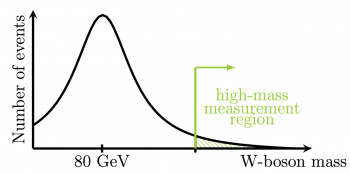News
Queen Mary particle physicists lead pioneering study of high-mass W-bosons at CERN
Faculty of Science and Engineering Centre for Fundamental Physics25 April 2025
Particle physicists at Queen Mary have used data from the Large Hadron Collider at CERN to help measure a key elementary particle, known as the W-boson, in mass regions never explored before. Their work explores previously uncharted mass regions, offering fresh clues about the forces that shape our universe.
The current model of particle physics, known as the Standard Model, has been extremely successful in describing the subatomic world around us and providing predictions for physical phenomena, even before their experimental observation. However, the Standard Model is not the full story, as it fails to explain several important physics phenomena that we observe, such as the presence of dark matter.
W-bosons play a vital role within the Standard Model, as they carry a fundamental force that affects the subatomic world, known as the weak force. Since their discovery in the 1980s, W-bosons have been extensively studied by physicists. Precise measurements of their properties help improve our understanding of the Standard Model and perhaps provide hints for what lies beyond it.
Despite this intensive study, there's still much to uncover, as W-bosons are only well-understood at their mass of about 80 GeV (the "peak" region). It is possible, however (although very rare) to produce W-bosons that are much heavier than this. Physicists at Queen Mary have been working alongside colleagues from all over the world to achieve the first-ever measurement of W-boson production probability – or cross section – at masses far beyond the peak region.
The measurement was performed by the ATLAS Collaboration, using data collected by the ATLAS detector. The detector measures the particles produced in high-energy proton collisions at the Large Hadron Collider (LHC) at CERN. By carefully analysing the decay products of these proton collisions, physicists can reconstruct and perform systematic measurements of the W-bosons.
So, how does the measurement compare to the prediction from the Standard Model? The measurement appears to be well in line with the Standard Model expectation, but the high precision of the measurement allows us to learn about the areas of the Standard Model we are less certain about.
For example, all theoretical predictions at the LHC require knowledge of the internal structure of the proton. The proton is composed of a vast and dynamic sea of quarks and gluons, which are described by functions known as "parton distribution functions" (PDFs). The PDFs must be measured, and this new measurement provides vital information for constraining the PDFs, which in turn improves the accuracy of theoretical predictions for many future measurements at the LHC.
Among the physicists involved in the measurement was doctoral student James Inglis, enrolled in the Data-Centric Engineering programme at Queen Mary, and Professor Eram Rizvi, Mr Inglis's supervisor and director of the DCE programme.
Mr Inglis used the measurement to constrain extensions of the Standard Model: "By treating the Standard Model as a so-called effective field theory, it is possible to use the measurement to constrain a wide range of theoretical extensions of the Standard Model. The measurement has allowed us to provide world-leading constraints on certain types of interactions between leptons and quarks, pushing the boundaries of where new physics could still be hiding."
This landmark measurement not only deepens our understanding of the proton's structure and electroweak interactions but also plays a vital role in the search for new physics at the highest energy scales. Queen Mary's involvement underscores its leading role in cutting-edge particle physics research.
For further details, see:
Email: [email protected]
Updated by: Ilyana Zolotareva





